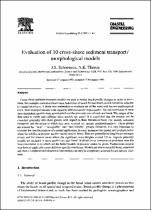JavaScript is disabled for your browser. Some features of this site may not work without it.
- ResearchSpace
- →
- Research Publications/Outputs
- →
- Journal Articles
- →
- View Item
| dc.contributor.author |
Schoonees, JS

|
en_US |
| dc.contributor.author |
Theron, AK

|
en_US |
| dc.date.accessioned | 2007-02-08T09:31:24Z | en_US |
| dc.date.accessioned | 2007-06-07T10:03:02Z | |
| dc.date.available | 2007-02-08T09:31:24Z | en_US |
| dc.date.available | 2007-06-07T10:03:02Z | |
| dc.date.copyright | en_US | |
| dc.date.issued | 1995-05 | en_US |
| dc.identifier.citation | Schoonees, JS and Theron, AK. 1995. Evaluation of 10 cross-shore sediment transport morphological models. Coastal Engineering, vol. 25, 02 January, pp 1-41 | en_US |
| dc.identifier.issn | 0378-3839 | en_US |
| dc.identifier.uri | http://hdl.handle.net/10204/1675 | en_US |
| dc.identifier.uri | http://hdl.handle.net/10204/1675 | |
| dc.description.abstract | Cross-shore sediment transport models are used to model beach profile changes in order to determine, for example, coastal set-back lines, behaviour of beach fill and beach profile variations adjacent to coastal structures. A study was undertaken to evaluate ten of the most well-known mathematical cross-shore transport models with regard to different model requirements. The characteristics of these time-dependent models were investigated and the pros and cons of each are listed. The ranges of the data used to verify and calibrate these models are noted. It is concluded that the models can be classified generally into three groups with regard to their theoretical basis (Re. mainly sediment transport) and the extent to which they were verified (re. mainly morphodynamics). These groups are termed the ''best'', ''acceptable'' and ''less suitable'' groups. However, it is very important to consider the specific purpose of a model application. In some instances one model may perform better while for a different purpose another model may be better. Data are generally lacking for accretionary events and for erosion cases where the significant wave heights exceed 2.5 m. Aspects presently usually not included in these models are also listed. Without direct comparative prototype tests the final conclusion as to which are the better models in practice cannot be given. Furthermore models may be best applicable under different specific conditions. Models are also constantly being improved and thus a comparative evaluation of the models can only be completely accurate for a relatively short time. | en_US |
| dc.format.extent | 3091315 bytes | en_US |
| dc.format.mimetype | application/pdf | en_US |
| dc.language.iso | en | en_US |
| dc.publisher | Elsevier Science BV | en_US |
| dc.rights | Copyright: 1995 Elsevier Science BV | en_US |
| dc.source | en_US | |
| dc.subject | Cross-shore transport models | en_US |
| dc.subject | Beach profile changes | en_US |
| dc.subject | Coastal Engineering | en_US |
| dc.subject | Morphological models | en_US |
| dc.title | Evaluation of 10 cross-shore sediment transport morphological models | en_US |
| dc.type | Article | en_US |
| dc.identifier.apacitation | Schoonees, J., & Theron, A. (1995). Evaluation of 10 cross-shore sediment transport morphological models. http://hdl.handle.net/10204/1675 | en_ZA |
| dc.identifier.chicagocitation | Schoonees, JS, and AK Theron "Evaluation of 10 cross-shore sediment transport morphological models." (1995) http://hdl.handle.net/10204/1675 | en_ZA |
| dc.identifier.vancouvercitation | Schoonees J, Theron A. Evaluation of 10 cross-shore sediment transport morphological models. 1995; http://hdl.handle.net/10204/1675. | en_ZA |
| dc.identifier.ris | TY - Article AU - Schoonees, JS AU - Theron, AK AB - Cross-shore sediment transport models are used to model beach profile changes in order to determine, for example, coastal set-back lines, behaviour of beach fill and beach profile variations adjacent to coastal structures. A study was undertaken to evaluate ten of the most well-known mathematical cross-shore transport models with regard to different model requirements. The characteristics of these time-dependent models were investigated and the pros and cons of each are listed. The ranges of the data used to verify and calibrate these models are noted. It is concluded that the models can be classified generally into three groups with regard to their theoretical basis (Re. mainly sediment transport) and the extent to which they were verified (re. mainly morphodynamics). These groups are termed the ''best'', ''acceptable'' and ''less suitable'' groups. However, it is very important to consider the specific purpose of a model application. In some instances one model may perform better while for a different purpose another model may be better. Data are generally lacking for accretionary events and for erosion cases where the significant wave heights exceed 2.5 m. Aspects presently usually not included in these models are also listed. Without direct comparative prototype tests the final conclusion as to which are the better models in practice cannot be given. Furthermore models may be best applicable under different specific conditions. Models are also constantly being improved and thus a comparative evaluation of the models can only be completely accurate for a relatively short time. DA - 1995-05 DB - ResearchSpace DP - CSIR KW - Cross-shore transport models KW - Beach profile changes KW - Coastal Engineering KW - Morphological models LK - https://researchspace.csir.co.za PY - 1995 SM - 0378-3839 T1 - Evaluation of 10 cross-shore sediment transport morphological models TI - Evaluation of 10 cross-shore sediment transport morphological models UR - http://hdl.handle.net/10204/1675 ER - | en_ZA |






